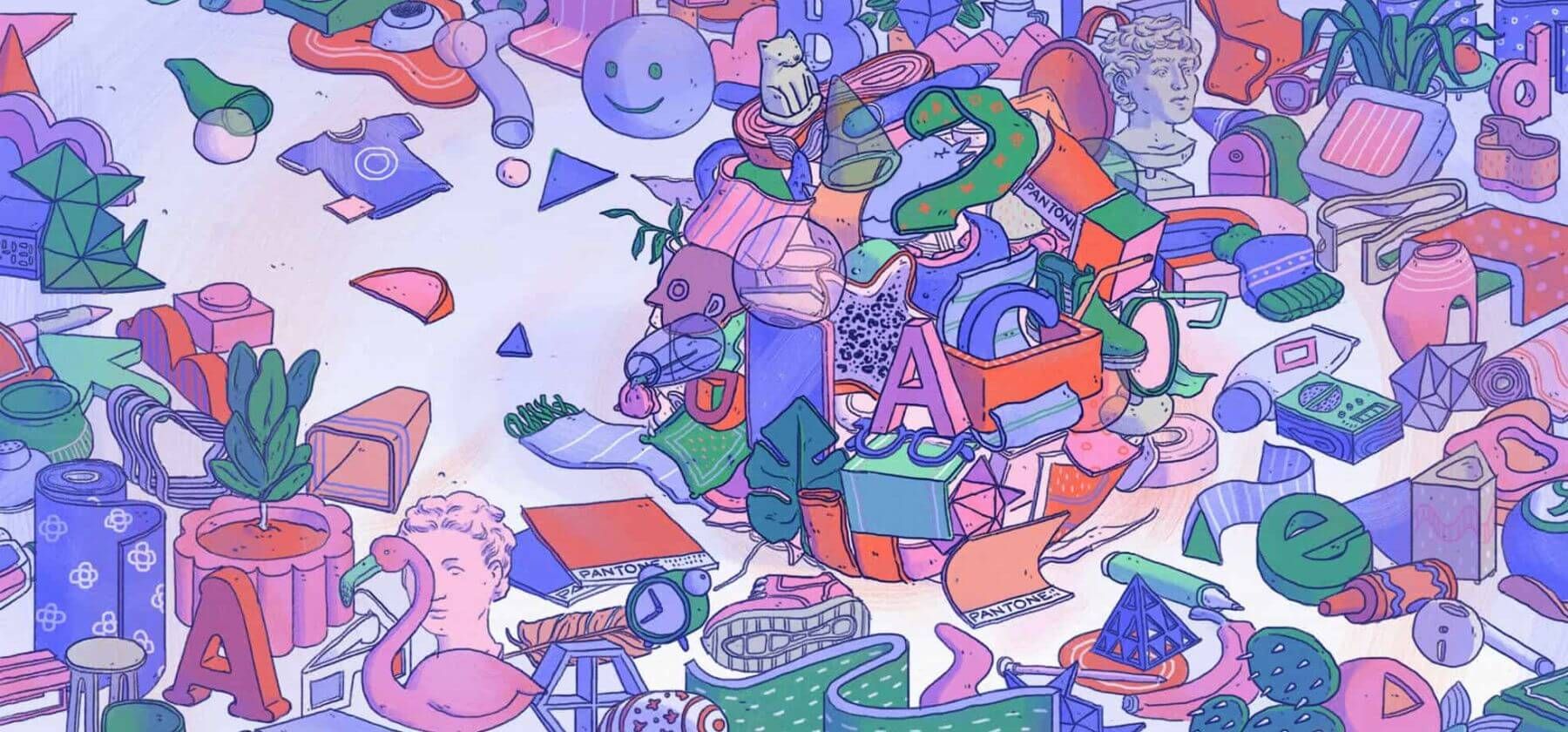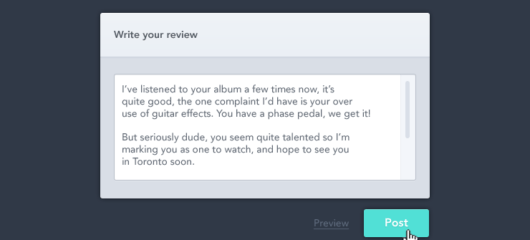
How to “steal like a designer” and boost creativity
Main illustration: Meredith Miotke
Originality is the holy grail of creativity. But does true originality exist in design or is it always influenced by what came before?
Let’s be honest: creativity is a nebulous landscape. With the evolution of digital technologies, we’re now exposed to other people’s opinions, ideas, and work on an almost minute-by-minute basis. So whether its originality of thought or artistic brilliance, the sheer scale of visual and conceptual input we experience on a daily basis can blur the lines between where your idea ends and mine begins.
But here’s the thing: humans can’t have new ideas without prior sensory input. It’s not me; it’s science, and it’s how our brains work. From composers, to philosophers, to modern-day tech moguls – some of the most brilliant minds of this century have observed that great artists remix, recontextualize, and build upon ideas that already exist to create work that inspires and influences others. The great composer Igor Stravinsky once said that, “A good composer does not imitate; he steals,” while Steve Jobs echoed this maxim in his 1996 statement that “Good artists copy, great artists steal.”
“Your mind is like a collection of LEGO bricks. You can’t conjure these bricks from thin air, they’re accumulated through different experiences and influences”
Not convinced? That’s ok, let’s test this hypothesis. Try drawing an animal, or a vegetable, or a fruit that doesn’t exist – you’ll end up with some bizarre drawings but each of them will be an elaborate combination of elements you’ve seen before.
In short, your mind is like a collection of LEGO bricks. You can’t conjure these bricks from thin air, they’re accumulated through different experiences and influences, but you can copy them, transform their shape and size, and combine them in new ways to form fresh ideas. Design works in exactly the same way. The more basic elements you have starting out, the more objects you can potentially create, and the more complex each object will be. The obvious question is: how and where can I get more of these bricks?
As you may have guessed from the title, the answer is — you can steal them.
Ok, ok, I’m not suggesting that you actually steal them. But I’d like to explore a few tips and tricks for mining creative inspiration across the visual, functional, and conceptual aspects of design based on my own experiences as a Product Designer at Intercom.
1. Explore visual elements
It may seem like an oxymoron, but taking the time to regularly study the building blocks of visual design – like buttons, objects, and the myriad uses of Gestalt principles in layouts – will save you time in the long run.
Maybe this seems irrelevant to you because you use a design system at work and rarely create patterns from scratch, or you feel that you simply don’t have the time to refine your user interface (UI) designs. While I can understand this reasoning, I disagree with this mindset – particularly when it comes to mastering the more granular aspects of UI design.
“But if you’ve seen thousands of similar layouts, you can quickly assemble your collection of LEGO bricks to form an innovative and effective design in half the time it would take to start from scratch”
UI refinement used to consume the majority of my time. I’ve reduced its impact on my workload by taking practical steps to strengthen my design sensibility. Creating mock ups of designs I admire has helped me to assemble a greater collection of visual design artefacts that I can draw on in my day-to-day designs – the more you practice, the faster you can complete your own deliverables. Time is precious when you’re a designer and the little things like measuring the distance between buttons or calculating the perfect margin all add up. But if you’ve seen thousands of similar layouts, you can quickly assemble your collection of LEGO bricks to form an innovative and effective design in half the time it would take to start from scratch.
Absorbing other artists’ work has the same effect on prototyping. Global VP of Design at IBM, Arin Bhowmich observes, “You might also have heard people tell you that if you’re wanting to test how someone will respond in a specific scenario, the closer the ‘test’ or ‘model’ corresponds to the reality that it is simulating, the more confident you can be that their behaviour in the test scenario will be truly representative of how they would react in the real scenario.” Drawing on a wider spectrum of visual artefacts to influence your work means you can render high-fidelity prototypes quicker and gather more accurate user feedback, speeding up each subsequent iteration of your design.
Put simply, the higher the fidelity, the higher the quality of the feedback you will receive. I’ve incorporated this “stolen” advice from my favourite article by the founder of the UX Collective, Fabricio Teixeira, into my own workflows. Consuming a variety of resources and perspectives has helped me to observe work from different angles and ultimately improved my output. So how can you build your own library of resources specific to your needs? Here are a few starting points:
- Browse sites that provide a variety of visuals, my favourites include Dribble, Pinterest, Sidebar, and the App Store.
- Collect and save the designs you like. I like to screenshot the designs that resonate with me and save them to a dropbox folder. Pinterest boards and dribble collections are also a good way to build a collection of ideas and concepts to draw on.
- Copy interfaces that you like. It’s a muscle-memory exercise that’s time consuming but pays off. You pick up the interface you like, take a screenshot, place it on a background layer in a Sketch/Figma file and recreate the whole page from scratch. I found this improved my ability to estimate distance between elements and pick up on design inconsistencies quicker.
- Repeat the steps above. The key to success in building any skill is regular practice. Doing a dribble raid once a year isn’t enough. Book 15 minutes in your calendar every day for a short spell of productive procrastination and spend it browsing and saving the work of designers and artists that you admire.
2. Identify winning functional designs
Once you’ve expanded your visual library, it’s time to delve deeper, moving beyond aesthetics to the mechanics of your designs. Collecting solutions, identifying useful features, and noting innovative products will enable you to produce viable solutions quicker.
Staying informed of best practices allows you to remix elements you have picked up along the way and contribute new solutions that in turn, influence other designers and styles. Examining how other companies’ approach problems will make it easier for you to create a pick and mix of useful references to address issues that you’re working on. You probably already do this, but I highly recommend you watch product releases, sign up for betas, and attend (virtually!) tech events. Over time you’ll find that this approach makes complex problem-solving less taxing.
3. Examine core principles
At this level, you’re scrutinizing the core principles underpinning the solutions, features, and visual treatment of products you admire or enjoy using in your daily life.
“Variety is key when boosting creative thinking”
Don’t limit yourself through industry or medium when it comes to broadening your understanding of design concepts. Real-life experiences and people can inform solutions. In fact, in his book Steal Like an Artist, writer Austin Kleon notes that, “There’s an economic theory out there that if you take the incomes of your five closest friends and average them, the resulting number will be pretty close to your income. I think the same thing is true of idea incomes. You’re only going to be as good as the stuff you surround yourself with.”
Tips for critical design thinking
Variety is key when boosting creative thinking. More than that, getting out of your routine and environment can help you find connections between seemingly unrelated things. According to IDEO Products Manager David Acyan, this form of experimentation is one of the six essential elements of creativity. Although it can be difficult to identify the reasoning or psychology behind a product that you’re not working on, it is possible. Here are a few tips for developing this style of critical design thinking:
- Question everything. Starting with your work, ask yourself why it works that way, and question the rationale behind seemingly obvious decisions. Read product blogs to help you expand your understanding of design rationale. Uber, Google, Netflix, Mapbox, and Spotify have written excellent articles about their design process. If you spend enough time researching products and company history, you’ll learn about the “why” behind the product and how it came to its current iteration. A simple exercise you can do for practice is to try and map a company’s Kano model from the first iteration to the existing product, examining the shift in delighters and satisfiers as the product evolved.
- Apply newly discovered principles to your work. For example, take a look at the Uber app. It has a slick UI, and on its surface, the design appears simple, but there’s more to this app beyond the aesthetics. In fact, there’s a principle known as “Idleness Aversion” at work behind the scenes that states that people are happier when they are busier, even if they’re forced to be busy. Uber customers’ most significant pain point is the wait, and this is where the rationale behind their design comes into play. Uber’s interface provides the user with animation, gamification, and visuals to engage and inform them as they wait for your ride. Maybe you work in digital health or fintech instead of transportation, but knowing this principle will allow you to apply it to your industry to boost your user experience.
Steal it before you need it
When working on a problem, it’s natural to look to your competitors and similar solutions for inspiration. But the point I’m trying to make is — steal this inspiration before you need it.
Through regular exploration of seemingly disparate design influences, you’ll curate an effective library of patterns, solutions, and ideas that expand far beyond your competitors’ space. Cultivating this visual language provides the fluency needed to remix and recontextualize your influences to produce original work.
Are you a product designer interested in solving these problems? Join our team – we’re hiring in Dublin, London, or remote in Ireland or the UK.








